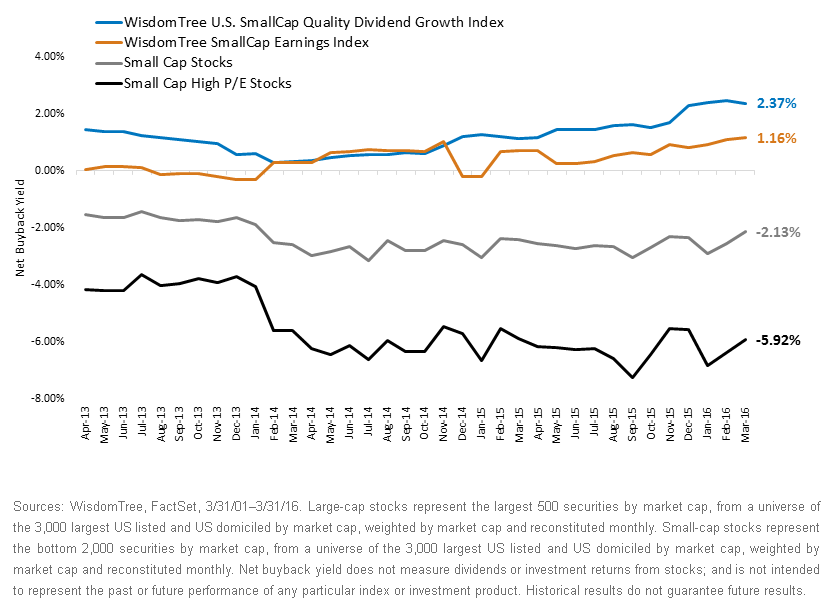The Difference between Small Cap Issuers and Buybackers


 In small caps, there is a large difference in the buyback yields of companies with high valuations (either companies losing money and needing to raise capital to fund their existence or companies selling at high price-to-earnings [P/E] ratios) compared to profitable companies and lower-priced companies.
Over the last three years, the high-priced small-cap stocks had an average net buyback yield of -5.5%, meaning there was a net capital issuance, and therefore a per-share drag of over 5% per year that they must overcome to drive future per-share earnings growth. When an investor selects just profitable companies and weights them by their Earnings Streams, the average buyback yield has been slightly positive over this same period.4
That was one net benefit of selecting and weighting universes by profits—you got an average improvement of almost 6 percentage points per year for the net buyback yields. One critical reason this occurred was the shift to lower-priced companies within that small-cap universe and the shift away from higher-priced stocks, which are doing the most capital raising. Managers are often responding to incentives: If they think their stocks are low priced, they are issuing fewer shares, whereas companies with higher valuations issue more stock and thus have a higher per-share hurdle to overcome.
Small-Cap Dividend Growers Were Also Higher Net Buybackers
The WisdomTree U.S. SmallCap Quality Dividend Growth Index (small-cap dividend growers), which selects companies based on high return on equity (ROE), high return on assets (ROA) and high earnings growth expectations, raised the net buyback yield even further. In contrast to the 5.9% net share issuance over the last year from the expensive small-cap stocks, the small-cap dividend growers had a 2.37% net buyback yield (over a 8-percentage-point differential).5
The net issuance that is taking place in this small-cap expensive-stock universe is one of the reasons I believe the small-cap growth category has a tough time outperforming the small-cap value category over time.
Companies that are constantly issuing shares have to achieve a higher growth rate to overcome the dilution from raising shares outstanding. The companies in our SmallCap Quality Dividend Growth Index are actually reducing their shares outstanding and are priced in such a way that expectations are lower and easier to overcome.
In a world in which growth is scarce, the WisdomTree U.S. SmallCap Quality Dividend Growth Index represents an interesting mix of both relatively attractive current dividend levels (especially compared to market cap-weighted indexes) and currently more attractive net buyback yields that could support per-share earnings growth. I believe this makes a powerful case for why these stocks could perform comparably well across time.
Small-Cap Net Buyback Yields
In small caps, there is a large difference in the buyback yields of companies with high valuations (either companies losing money and needing to raise capital to fund their existence or companies selling at high price-to-earnings [P/E] ratios) compared to profitable companies and lower-priced companies.
Over the last three years, the high-priced small-cap stocks had an average net buyback yield of -5.5%, meaning there was a net capital issuance, and therefore a per-share drag of over 5% per year that they must overcome to drive future per-share earnings growth. When an investor selects just profitable companies and weights them by their Earnings Streams, the average buyback yield has been slightly positive over this same period.4
That was one net benefit of selecting and weighting universes by profits—you got an average improvement of almost 6 percentage points per year for the net buyback yields. One critical reason this occurred was the shift to lower-priced companies within that small-cap universe and the shift away from higher-priced stocks, which are doing the most capital raising. Managers are often responding to incentives: If they think their stocks are low priced, they are issuing fewer shares, whereas companies with higher valuations issue more stock and thus have a higher per-share hurdle to overcome.
Small-Cap Dividend Growers Were Also Higher Net Buybackers
The WisdomTree U.S. SmallCap Quality Dividend Growth Index (small-cap dividend growers), which selects companies based on high return on equity (ROE), high return on assets (ROA) and high earnings growth expectations, raised the net buyback yield even further. In contrast to the 5.9% net share issuance over the last year from the expensive small-cap stocks, the small-cap dividend growers had a 2.37% net buyback yield (over a 8-percentage-point differential).5
The net issuance that is taking place in this small-cap expensive-stock universe is one of the reasons I believe the small-cap growth category has a tough time outperforming the small-cap value category over time.
Companies that are constantly issuing shares have to achieve a higher growth rate to overcome the dilution from raising shares outstanding. The companies in our SmallCap Quality Dividend Growth Index are actually reducing their shares outstanding and are priced in such a way that expectations are lower and easier to overcome.
In a world in which growth is scarce, the WisdomTree U.S. SmallCap Quality Dividend Growth Index represents an interesting mix of both relatively attractive current dividend levels (especially compared to market cap-weighted indexes) and currently more attractive net buyback yields that could support per-share earnings growth. I believe this makes a powerful case for why these stocks could perform comparably well across time.
Small-Cap Net Buyback Yields
 1Source: Fama & French, 3/31/1966–3/31/2016. Click here for more information about their methodology. The portfolios, which are constructed at the end of each June, are the intersections of 2 portfolios formed on size (market equity, ME) and 3 portfolios formed on the ratio of book equity to market equity (BE/ME). Small Cap Value would be the smallest 50% by ME and the highest 30% by BE/ME. Small Cap Growth would be the smallest 50% by ME and the lowest 30% by BE/ME.
2Sources: WisdomTree, Bloomberg, 4/30/06–4/30/16. References the MSCI ACWE Growth Index outperformance of MSCI ASWI Value Index.
3A company’s net share buyback is the difference between the capital raised by issuing new shares and the money the company spent on buying back any outstanding shares. A positive net share buyback means that more was spent on buying back existing shares than received from issuing new shares. Net buyback yield is the amount of a company’s net buybacks divided by its market capitalization. Please note that net buyback yield does not represent a dividend paid by the company.
4High-priced small-cap stocks refer to the 50% highest-priced stocks from a P/E perspective within the small-cap stock universe. Small-cap profitable stocks weighted by Earnings Stream refers to the WisdomTree SmallCap Earnings Index.
5Sources: WisdomTree, FactSet, as of 3/31/16.
1Source: Fama & French, 3/31/1966–3/31/2016. Click here for more information about their methodology. The portfolios, which are constructed at the end of each June, are the intersections of 2 portfolios formed on size (market equity, ME) and 3 portfolios formed on the ratio of book equity to market equity (BE/ME). Small Cap Value would be the smallest 50% by ME and the highest 30% by BE/ME. Small Cap Growth would be the smallest 50% by ME and the lowest 30% by BE/ME.
2Sources: WisdomTree, Bloomberg, 4/30/06–4/30/16. References the MSCI ACWE Growth Index outperformance of MSCI ASWI Value Index.
3A company’s net share buyback is the difference between the capital raised by issuing new shares and the money the company spent on buying back any outstanding shares. A positive net share buyback means that more was spent on buying back existing shares than received from issuing new shares. Net buyback yield is the amount of a company’s net buybacks divided by its market capitalization. Please note that net buyback yield does not represent a dividend paid by the company.
4High-priced small-cap stocks refer to the 50% highest-priced stocks from a P/E perspective within the small-cap stock universe. Small-cap profitable stocks weighted by Earnings Stream refers to the WisdomTree SmallCap Earnings Index.
5Sources: WisdomTree, FactSet, as of 3/31/16.Important Risks Related to this Article
Dividends are not guaranteed, and a company’s future ability to pay dividends may be limited. A company currently paying dividends may cease paying dividends at any time.

Jeremy Schwartz has served as our Global Chief Investment Officer since November 2021 and leads WisdomTree’s investment strategy team in the construction of WisdomTree’s equity Indexes, quantitative active strategies and multi-asset Model Portfolios. Jeremy joined WisdomTree in May 2005 as a Senior Analyst, adding Deputy Director of Research to his responsibilities in February 2007. He served as Director of Research from October 2008 to October 2018 and as Global Head of Research from November 2018 to November 2021. Before joining WisdomTree, he was a head research assistant for Professor Jeremy Siegel and, in 2022, became his co-author on the sixth edition of the book Stocks for the Long Run. Jeremy is also co-author of the Financial Analysts Journal paper “What Happened to the Original Stocks in the S&P 500?” He received his B.S. in economics from The Wharton School of the University of Pennsylvania and hosts the Wharton Business Radio program Behind the Markets on SiriusXM 132. Jeremy is a member of the CFA Society of Philadelphia.

